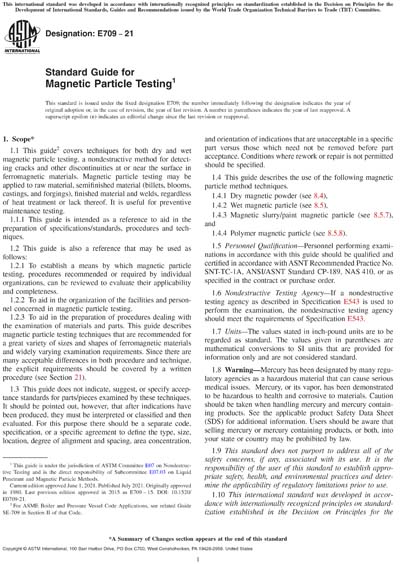Most recent
ASTM E709-21
Standard Guide for Magnetic Particle Testing
1.1This guide2 covers techniques for both dry and wet magnetic particle testing, a nondestructive method for detecting cracks and other discontinuities at or near the surface in ferromagnetic materials. Magnetic particle testing may be applied to raw material, semifinished material (billets, blooms, castings, and forgings), finished material and welds, regardless of heat treatment or lack thereof. It is useful for preventive maintenance testing.
1.1.1This guide is intended as a reference to aid in the preparation of specifications/standards, procedures and techniques.
1.2This guide is also a reference that may be used as follows:
1.2.1To establish a means by which magnetic particle testing, procedures recommended or required by individual organizations, can be reviewed to evaluate their applicability and completeness.
1.2.2To aid in the organization of the facilities and personnel concerned in magnetic particle testing.
1.2.3To aid in the preparation of procedures dealing with the examination of materials and parts. This guide describes magnetic particle testing techniques that are recommended for a great variety of sizes and shapes of ferromagnetic materials and widely varying examination requirements. Since there are many acceptable differences in both procedure and technique, the explicit requirements should be covered by a written procedure (see Section 21).
1.3This guide does not indicate, suggest, or specify acceptance standards for parts/pieces examined by these techniques. It should be pointed out, however, that after indications have been produced, they must be interpreted or classified and then evaluated. For this purpose there should be a separate code, specification, or a specific agreement to define the type, size, location, degree of alignment and spacing, area concentration, and orientation of indications that are unacceptable in a specific part versus those which need not be removed before part acceptance. Conditions where rework or repair is not permitted should be specified.
1.4This guide describes the use of the following magnetic particle method techniques.
1.4.1Dry magnetic powder (see 8.4),
1.4.2Wet magnetic particle (see 8.5),
1.4.3Magnetic slurry/paint magnetic particle (see 8.5.7), and
1.4.4Polymer magnetic particle (see 8.5.8).
1.5Personnel Qualification - Personnel performing examinations in accordance with this guide should be qualified and certified in accordance with ASNT Recommended Practice No. SNT-TC-1A, ANSI/ASNT Standard CP-189, NAS 410, or as specified in the contract or purchase order.
1.6Nondestructive Testing Agency - If a nondestructive testing agency as described in Specification E543 is used to perform the examination, the nondestructive testing agency should meet the requirements of Specification E543.
1.7Units - The values stated in inch-pound units are to be regarded as standard. The values given in parentheses are mathematical conversions to SI units that are provided for information only and are not considered standard.
1.8Warning - Mercury has been designated by many regulatory agencies as a hazardous material that can cause serious medical issues. Mercury, or its vapor, has been demonstrated to be hazardous to health and corrosive to materials.Caution should be taken when handling mercury and mercury containing products. See the applicable product Safety Data Sheet (SDS) for additional information. Users should be aware that selling mercury or mercury containing products, or both, into your state or country may be prohibited by law.
1.9This standard does not purport to address all of the safety concerns, if any, associated with its use. It is the responsibility of the user of this standard to establish appropriate safety, health, and environmental practices and determine the applicability of regulatory limitations prior to use.
1.10This international standard was developed in accordance with internationally recognized principles on standardization established in the Decision on Principles for the Development of International Standards, Guides and Recommendations issued by the World Trade Organization Technical Barriers to Trade (TBT) Committee.
Content Provider
ASTM International [astm]






